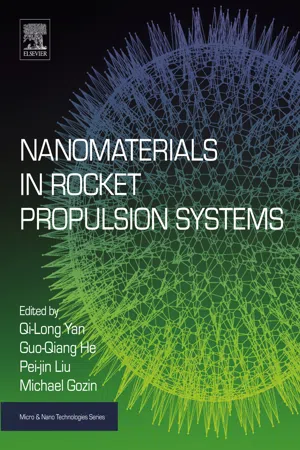
Nanomaterials in Rocket Propulsion Systems
- 592 pages
- English
- ePUB (mobile friendly)
- Available on iOS & Android
Nanomaterials in Rocket Propulsion Systems
About this book
Nanomaterials in Rocket Propulsion Systems covers the fundamentals of nanomaterials and examines a wide range of innovative applications, presenting the current state-of-the-art in the field. Opening with a chapter on nano-sized energetic materials, the book examines metal nanoparticles-based fuels, ballistic modifiers, stabilizers and catalysts as the components of rocket propellants. Hydrogen storage materials for rocket propulsion based on nanotubes are then discussed, as are nano-porous materials and metal organic frameworks, nano-gelled propellants, nano-composite ablators and ceramic nano-composites. Other applications examined include high thermal conductivity metallic nano-composite nozzle liners, nano-emitters for Coulomb propulsion of space-crafts, and highly thermostable nano-ceramics for rocket motors.The book finishes with coverage of combustion of nano-sized rocket fuels, nano-particles and their combustion in micro- and nano-electromechanical systems (MEMS/NEMS), plasma propulsion and nano-scale physics. Users will find this to be a valuable resource for academic and government institutions, professionals, new researchers and graduate students working in the application of nanomaterials in the aerospace industry.- Provides a detailed overview of different types of nanomaterials used in rocket propulsion, highlighting different situations in which different materials are used- Demonstrates the use of new nanomaterial concepts, allowing for an increase in payload capacity or a decrease in launch mass- Explores a range of applications using metal nanopowders, presenting a panorama on cutting-edge, technological developments
Frequently asked questions
- Essential is ideal for learners and professionals who enjoy exploring a wide range of subjects. Access the Essential Library with 800,000+ trusted titles and best-sellers across business, personal growth, and the humanities. Includes unlimited reading time and Standard Read Aloud voice.
- Complete: Perfect for advanced learners and researchers needing full, unrestricted access. Unlock 1.4M+ books across hundreds of subjects, including academic and specialized titles. The Complete Plan also includes advanced features like Premium Read Aloud and Research Assistant.
Please note we cannot support devices running on iOS 13 and Android 7 or earlier. Learn more about using the app.
Information
The Prospects of Using Nanoenergetic Materials in Solid Rocket Propulsion
Abstract
Keywords
1. Introduction
Table of contents
- Cover image
- Title page
- Table of Contents
- Copyright
- Dedication
- Contributors
- Preface
- Part 1. Nanomaterials in Rocket Fuels
- Part 2. Nano-Engineered Propellants and Propulsion
- Part 3. Nanomaterials for Rocket Motors Hardware
- Author Index
- Subject Index